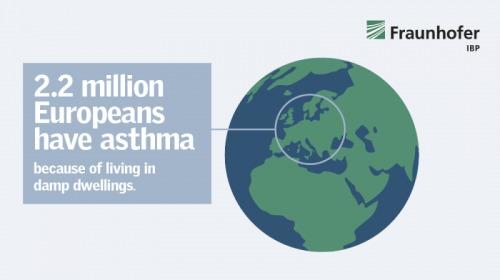Respiratory illnesses cost European Governments 82 billion Euros per year

The research from Fraunhofer IBP reveals the socio-economic costs of asthma and COPD, which are proven effects also of living in damp and unhealthy buildings. The costs are 82 billion Euros annually, covering European governments’ direct expenses on medical treatment and additional care for patients in- and outside of hospitals, as well as indirect costs due to loss of productivity.
The study also reveals that close to 84 million Europeans live in damp or mouldy dwellings, which increases their risk of having respiratory diseases and life-long allergies by 40%. This proves the number of people living in unhealthy buildings remains an issue, despite recent awareness of the correlation between indoor environment and human health.
Fraunhofer IBP’s research, based on cross-sectional study, questionnaires and in-depth case studies across 32 European countries, estimates that the number of Europeans living in damp and unhealthy dwellings could be reduced by 50% by 2050, which could reduce the number of people with associated respiratory diseases by 25%. In the case of asthma, this could lead to a reduction of 550,000 people.
He points to the upcoming revision of Energy Performance of Buildings Directives (EPBD) under the Energy Union, where the framework for national building legislations will be set. Here it is key that requirements for indoor climate is part of the agenda.
How to prevent dampness in homes
According to the Fraunhofer IBP institute, dampness is one of the main defects in buildings across Europe, primarily caused by inadequate building structures and home owners’ lack of attention to ventilate sufficiently.Consequently, mould is likely to grow, however the risk of this can be reduced by taking certain precautions at home:
Moulds thrive best on surfaces with temperatures around 15oC and in high air humidity. Walls with warmer indoor than outdoor surfaces are likely to trigger growth.
Frequent ventilation of the house is an efficient way of preventing mould to grow, and it is recommended to air out two times daily for at least ten minutes.
In April 2016 the VELUX Group completed the RenovActive project in Belgium, a home renovation based on ActiveHouse principles focusing on the building’s architectural quality, human health, comfort and well-being, energy efficiency, and environmental benefits.
A key element in the modernization is the prevention of indoor dampness and mould, which is ensured by a natural and continuous airflow in the house. Read more about RenovActive by clicking here.
The Fraunhofer IBP white paper, ‘Towards an identification of European indoor environments’ impact on health and performance,’ is now available on our website.
News published on VELUX
Consult the source



